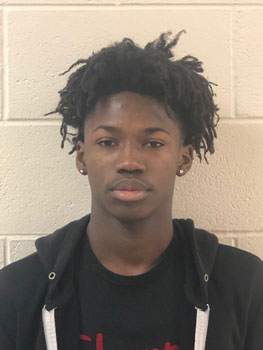 Just as Cumberland County was hoping to celebrate a pos-sible high point in mid-March with two state basketball champions, the high school athletic season across the state of North Carolina came to a crashing half because of restrictions imposed to pre-vent the spread of the COVID-19 virus.
Just as Cumberland County was hoping to celebrate a pos-sible high point in mid-March with two state basketball champions, the high school athletic season across the state of North Carolina came to a crashing half because of restrictions imposed to pre-vent the spread of the COVID-19 virus.
Not only was the basketball season prevented from ending on the court, spring sports athletes saw their seasons end after just a week, and they were eventually canceled.
 But while the year may have ended abruptly for many county athletes, there were some who were able to com-plete their seasons. Here’s
But while the year may have ended abruptly for many county athletes, there were some who were able to com-plete their seasons. Here’s
a quick recap of the athletic year by season.
Fall
Football — South View and Terry Sanford finished with 7-1 conference records in the Patriot Athletic Conference with the Tigers winning the
head-to-head matchup on the field 23-17 in a game that went double overtime.
 Dorian Clark led the county in rushing with 2,346 yards. The top passer was Dashawn McCullough of E.E. Smith with 2,336 yards.
Dorian Clark led the county in rushing with 2,346 yards. The top passer was Dashawn McCullough of E.E. Smith with 2,336 yards.
Volleyball — Gray’s Creek cruised to the Patriot Athletic Conference title with a 25-1 record, led by Kylie Aldridge and Kelsie Rouse with 77 and 70 aces respectively.
Boys soccer — Gray’s Creek edged Terry Sanford for the Patriot Athletic Conference title, finishing one game ahead of the Bulldogs in the league stan- dings. Eric Chavez was the leading scorer for the Bears with 17 goals and 14 assists.
dings. Eric Chavez was the leading scorer for the Bears with 17 goals and 14 assists.
Girls tennis — Cape Fear ended a 17-year losing streak to perennial county tennis power Terry Sanford, beating the Bulldogs 6-3. Terry Sanford wound up as the No. 1 seed in the state playoffs while Cape Fear earned a wildcard berth. Cape Fear reached the third round of the state 3-A playoffs, ended 14-2 after losing to unbeaten New Hanover.
The Colts were led by Brooke Bieniek and Paige Cameron.
Cross country — Octavious Smith of E.E. Smith was the top male runner in the county, winning the Patriot Athletic Conference meet with a time of  16:09.10. Cape Fear, led by Jonathan Piland and Julius Ferguson, was the team winner for the boys.
16:09.10. Cape Fear, led by Jonathan Piland and Julius Ferguson, was the team winner for the boys.
For the girls, Terry Sanford’s Rainger Pratt won with a time of 20:21.90. The Bulldogs also took the team prize.
Girls golf — Toni Blackwell again led Cape Fear to the Patriot Athletic Conference title. She went on to win the 3-A East Regional tournament and placed third in the NCHSAA tournament. For the regular season, Blackwell averaged 77.9 per round.
 Winter
Winter
Basketball — Westover’s boys and E.E. Smith’s girls came within days of playing for state 3-A bas-ketball titles, only to have the restrictions put into place because of COVID-19 see their games first postponed and eventually canceled. The NCHSAA Board of Directors eventually decided to declare all of the teams that had advanced to this year’s state basketball finals cochampions.
The Westover boys were led by D’Marco Dunn, who averaged 20.8 points per game and has recei-ved numerous college scholarship offers.
Miya Giles-Jones was Smith’s leading scorer with 13.4 points per game.
Wrestling — South View edged Cape Fear for the Patriot Athletic Conference regular season honors, but the Colts brought home more state hardware. Dallas Wilson won his third consecutive state individual title for Cape Fear while teammate Nick Minacapelli won his first title after a third-place finish a year ago. Wilson was also named the Most Outstanding Wrestler at the state 3-A tournament.
Bowling — It was a banner year for local bow-ling as the Gray’s Creek boys and Terry Sanford girls captured state championships.
Junior Zoe Cannady helped pace Terry Sanford while on the boys’ side Terry Sanford’s Rolf Wallin won the boys’ state individual title.
The Gray’s Creek boys were led by regular sea-son MVP C.J. Woodle and Gio Garcia.
Swimming — Cape Fear’s boys and Terry Sanford’s girls were the top swim teams in the county. Among the top swimmers were Terry Sanford’s Allison Curl and Pine Forest’s Brandon Chhoeung.
Spring
Baseball — Gray’s Creek was off to a 5-0 start when the season ended. Ben Jones was batting .667.
Softball — Cape Fear was 6-0 and South View 3-0. The top three hitters were Kylie Aldridge of Gray’s Creek at .727, Morgan Nunnery of Cape Fear at .722 and Jaden Pone of Gray’s Creek at .714.
Girls soccer — Terry Sanford was off to a 4-0 start led by eight goals from Maiya Parrous and seven from Corrinne Shovlain.
Track, golf, tennis and lacrosse seasons were practi-cally wiped out by the COVID-19 restrictions.
Major Awards
Here is a list of all Cumberland County Schools athletes that received major individual awards from their conferences during 2019-20: Patriot Athletic Conference
Football
Athlete of the Year —
Matthew Pemberton, South View
Offensive Player of the Year — Dorian Clark, Terry Sanford
Defensive Player of the Year — Jackson Deaver, Terry Sanford
Volleyball
MVP — Kylie Aldridge, Gray’s Creek
Boys Soccer
Offensive Player of the Year — Carlos Villarreal, Pine Forest
Defensive Player of the Year — Davis Molnar, Terry Sanford
Goal Keeper of the Year — Davin Schmidt, South View
Girls Tennis — Kelcie Farmer, Pine Forest Boys Cross Country — Octavious Smith, E.E. Smith
Girls Cross Country — Rainger Pratt, Terry Sanford
Girls Golf — Toni Blackwell, Cape Fear
Boys Basketball — D’Marco Dunn, Westover Girls Basketball — Faith Francis, Westover Wrestling — Dallas Wilson, Cape Fear
Boys Bowling — C.J. Woodle, Gray’s Creek Girls Bowling — Donna Kerechanin, South View Girls Swimming— Allison Curl, Terry Sanford Boys Swimming — Aiden Stockham and Brandon Chheoung, Pine Forest
Cheerleading — Avery Schenk, Terry Sanford Sandhills Athletic Conference
Swimming — Anna Miller, Jack Britt
From top to bottom: Matthew Pemberton, Kylie Aldridge, Miya Giles-Jones, Dallas Wilson, D'Marco Dunn, Toni Blackwell
Photo credit for Giles-Jones: Matthew Plyler/MaxPreps
 How to resolve AdBlock issue?
How to resolve AdBlock issue?  How to resolve AdBlock issue?
How to resolve AdBlock issue?  How to resolve AdBlock issue?
How to resolve AdBlock issue?  How to resolve AdBlock issue?
How to resolve AdBlock issue?  How to resolve AdBlock issue?
How to resolve AdBlock issue?  How to resolve AdBlock issue?
How to resolve AdBlock issue? 





